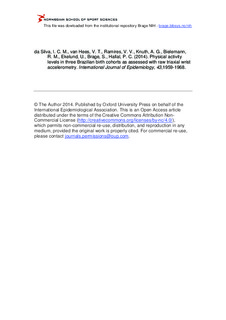| dc.contributor.author | Da Silva, Inacio C. M. | |
| dc.contributor.author | van Hees, Vincent T. | |
| dc.contributor.author | Ramires, Virgilio V. | |
| dc.contributor.author | Knuth, Alan G. | |
| dc.contributor.author | Bielemann, Renata M. | |
| dc.contributor.author | Ekelund, Ulf | |
| dc.contributor.author | Brage, Søren | |
| dc.contributor.author | Hallal, Pedro C. | |
| dc.date.accessioned | 2015-06-03T08:11:06Z | |
| dc.date.available | 2015-06-03T08:11:06Z | |
| dc.date.issued | 2014-10-30 | |
| dc.identifier.citation | International Journal of Epidemiology. 2014, 43, 1959-1968 | nb_NO |
| dc.identifier.uri | http://hdl.handle.net/11250/284473 | |
| dc.description | © The Author 2014. Published by Oxford University Press on behalf of the International Epidemiological Association This is an Open Access article distributed under the terms of the Creative Commons Attribution Non-Commercial License (http://creativecommons.org/licenses/by-nc/4.0/), which permits non-commercial re-use, distribution, and reproduction in any medium, provided the original work is properly cited. For commercial re-use, please contact journals.permissions@oup.com | nb_NO |
| dc.description.abstract | Background: Data on objectively measured physical activity are lacking in low- and middle-income countries. The aim of this study was to describe objectively measured overall physical activity and time spent in moderate-to-vigorous physical activity (MVPA) in individuals from the Pelotas (Brazil) birth cohorts, according to weight status, socioeconomic status (SES) and sex.
Methods: All children born in 1982, 1993 and 2004 in hospitals in the city of Pelotas, Brazil, constitute the sampling frame; of these 99% agreed to participate. The most recent follow-ups were conducted between 2010 and 2013. In total, 8974 individuals provided valid data derived from raw triaxial wrist accelerometry. The average acceleration is presented in milli-g (1 mg = 0.001g), and time (min/d) spent in MVPA (>100 mg) is presented in 5- and 10-min bouts.
Results: Mean acceleration in the 1982 (mean age 30.2 years), 1993 (mean age 18.4 years) and 2004 (mean age 6.7 years) cohorts was 35 mg, 39 mg and 60 mg, respectively. Time spent in MVPA was 26 [95% confidence interval (CI) 25; 27], 43 (95% CI 42; 44) and 45 (95% CI 43; 46) min/d in the three cohorts, respectively, using 10-min bouts. Mean MVPA was on average 42% higher when using 5-min bouts. Males were more active than females and physical activity was inversely associated with age of the cohort and SES. Normal-weight individuals were more active than underweight, overweight and obese participants.
Conclusions: Overall physical activity and time spent in MVPA differed by cohort (age), sex, weight status and SES. Higher levels of activity in low SES groups may be explained by incidental physical activity. | nb_NO |
| dc.language.iso | eng | nb_NO |
| dc.publisher | Oxford University Press | nb_NO |
| dc.subject | activity monitor | nb_NO |
| dc.subject | cohort studies | nb_NO |
| dc.subject | motor activity | nb_NO |
| dc.subject | movement | nb_NO |
| dc.title | Physical activity levels in three Brazilian birth cohorts as assessed with raw triaxial wrist accelerometry | nb_NO |
| dc.type | Journal article | nb_NO |
| dc.type | Peer reviewed | nb_NO |
| dc.subject.nsi | VDP::Medical disciplines: 700 | nb_NO |
| dc.source.journal | International Journal of Epidemiology | nb_NO |
| dc.description.localcode | Seksjon for idretssmedisinske fag / Department of Sports Medicine | nb_NO |
